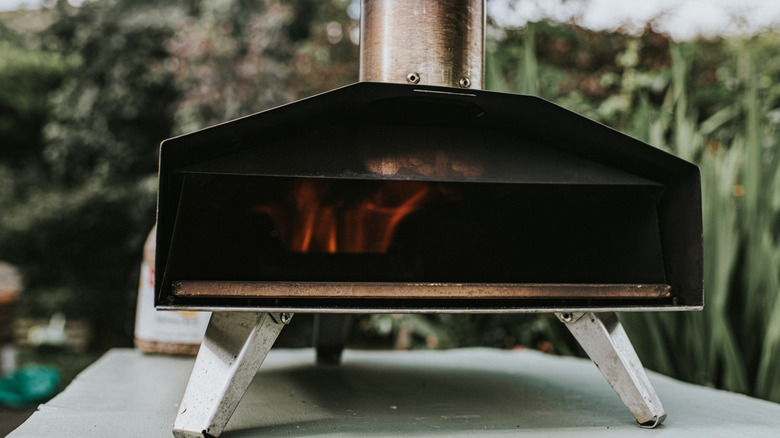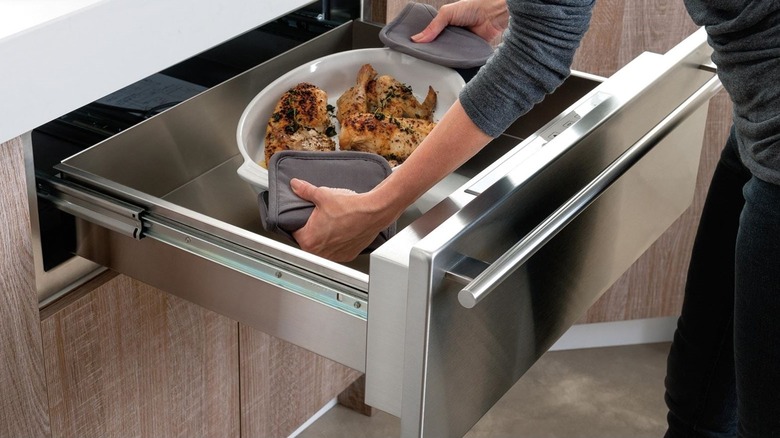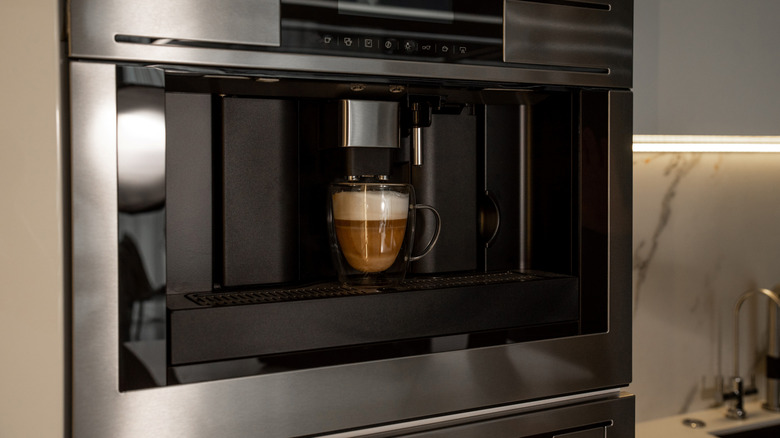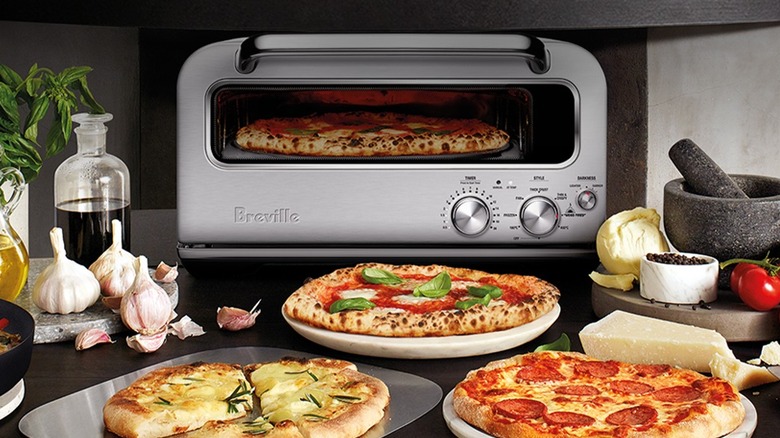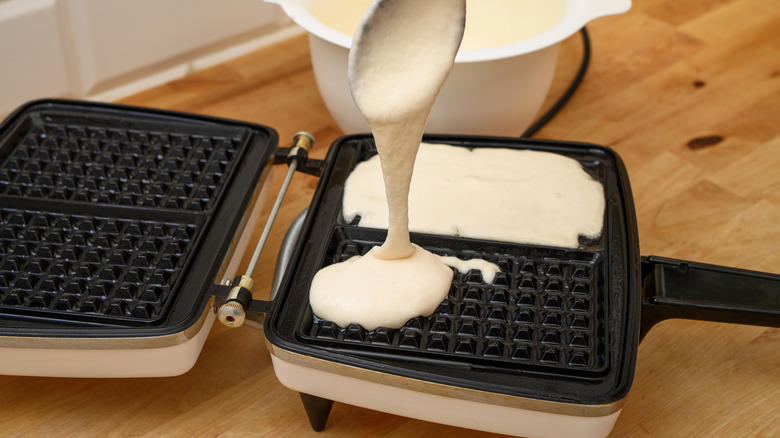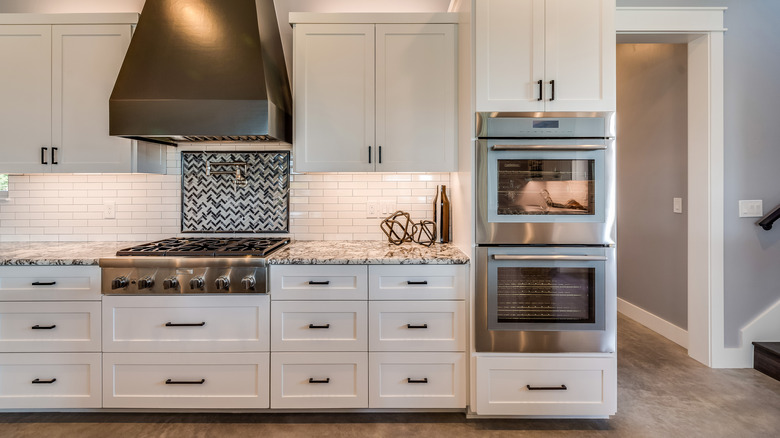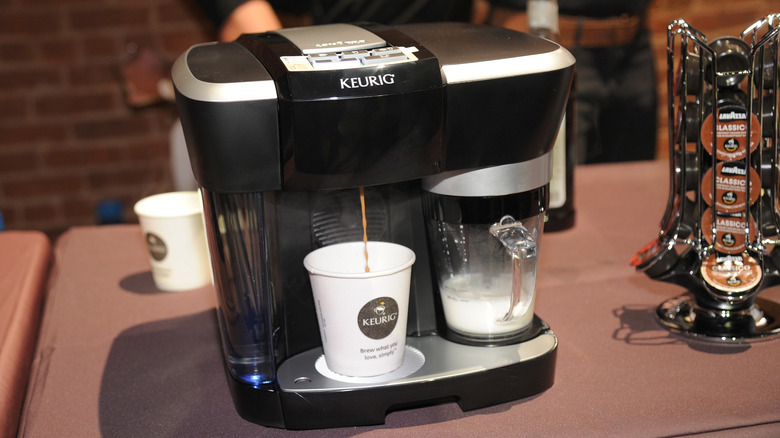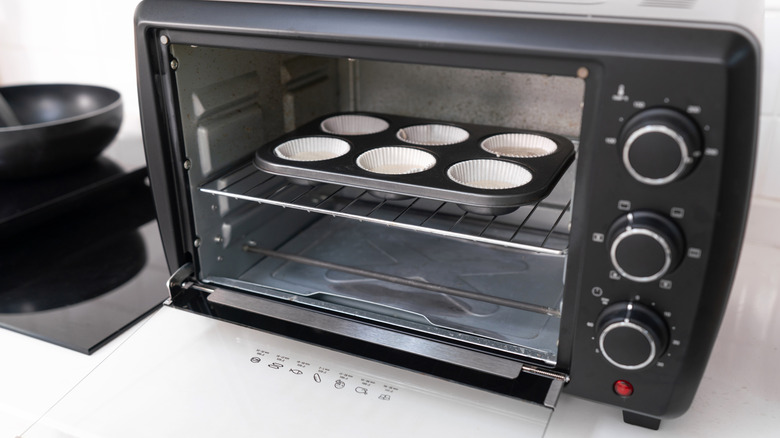Kitchen Appliances That Seem Handy But You Shouldn't Waste Your Money On
We may receive a commission on purchases made from links.
Investing in trendy kitchen appliances will make your kitchen look current. However, not every device is worth spending your hard-earned money on, especially if you end up using it minimally. "When it comes to kitchen appliances, there are definitely some that are aesthetically pleasing but really just end up being an expensive dust-gathering nuisance," Sienna Blake, designer at CabinetNow.com, points out to House Digest. For instance, you might think that a warming drawer will become an indispensable part of your kitchen operations. But it won't come in handy if you rarely eat dinner separately from your family or don't enjoy throwing dinner parties. Instead, you'd be giving up valuable cabinet space for something that barely gets any play.
Because of this, steer clear of adding devices to your kitchen unless absolutely necessary. Don't fall for the latest trends or deceptively convincing marketing. In case you're struggling to single out gadgets that won't serve a purpose, Blake proposes, "Overall, if an appliance serves a single or niche purpose, it's worth asking whether you'll use it daily — or if it'll just add clutter and maintenance to your kitchen." If the answer isn't satisfactory, don't purchase it. Need a little nudge in the right direction? Here are eight kitchen appliances our experts believe aren't worth the investment, along with the reasons why you shouldn't bring them home.
Warming drawers are expensive, take up precious space, and require regular upkeep
A warming drawer's USP is that it helps maintain cooked food at a consistent temperature without drying it out. Plus, the device can warm up plates and glasses, defrost frozen items, and proof bread dough. So, given their versatility, it might seem like a no-brainer to add them to your kitchen. However, they aren't a solid investment for multiple reasons. Blake cautions, "One of the most ubiquitous offenders is the warming drawer. While it looks like a high-end luxury feature, many homeowners don't feel the need for it — particularly given that many of today's ovens come with a 'keep warm' feature that will do the very same thing."
Moreover, it's quite expensive. You can expect to spend anywhere between $1,400 and $3,200 (or higher for premium models), depending on the model and features you go for. That's not it. You'll also have to spend money on its installation. This is because it requires electricity to function and you'll need a licensed professional to connect it to a power source. Still wondering if a warming drawer is worth it? It'll take up precious real estate in your kitchen, especially if you're working with limited square footage. Blake agrees and adds, "Warming drawers also take up valuable lower cabinet space that could be better utilized for storage, and they are so easy to forget about when you're busy cooking and serving."
Built-in coffee makers are inflexible, high-maintenance, pricey, and costly to repair
There's no denying that built-in coffee makers look elegant. They also don't commandeer counter space in your kitchen like freestanding units, and encourage beverage personalization, allowing you to enjoy your coffee your way. Further, some models are Wi-Fi-friendly and can brew you a quick cup with the touch of a button on your smart device. However, don't fall for this passing kitchen appliance trend. For starters, you'll need to earmark a cabinet for the appliance to fit in, so while it won't take up counter space, it'll occupy a whole cupboard unit. Additionally, it's high-maintenance. "While it gives a sleek look and the illusion of barista-quality drinks at home, they can be extremely high-maintenance, requiring frequent descaling, cleaning, and expensive repairs," Blake warns.
Although some models are equipped with a self-cleaning cycle, you'll still have to wipe down the milk frother after each cup, which can be annoying if you have a busy lifestyle. Additionally, you'll need to wipe the drip tray and its cover, the coffee grounds holder, and the milk tube regularly. Worse, you'll be paying upwards of $3,600 (up to $6,500) for the machine alone. Installation costs will be a separate issue. Plus, if you opt for a plumbed-in model, you'll also have to contract a plumber to connect the water line to the appliance. Given these cons, "years later, the vast majority of householders tend to revert to an old-fashioned countertop machine or just plain conventional coffee brewing," Blake shares.
Countertop pizza ovens will commandeer at least a foot of your kitchen countertop and are difficult to care for
Getting an electric pizza oven might seem like the next best alternative if you don't have a lot of space outdoors. It's more convenient than wood or gas models, you can use it to thaw and heat frozen pies and pretzels, and you don't have to worry about installation since you can simply plug in the appliance and make some pies on your countertop. Unfortunately, these pros come at a steep cost. "Countertop pizza ovens are another big but underperforming product; while they cook a great slice, they take up a lot of space, are hard to clean, and typically do just one thing — so most of their owners simply store them away after a couple of uses," Blake warns.
You'll have to sacrifice a square foot of countertop space (minimum!) to have these ovens handy whenever you feel like making a pizza. Even if you put it away in your cupboard or pantry, you'll still need to set aside a significant amount of space on the shelf. Regarding cleaning, you'll have to wipe the interior and exterior after each use with a damp microfiber cloth to get rid of the food crumbs, loose flour, and dripped sauce. You might also have to break out your pizza oven bristle brush, such as Cuisinart's 18-Inch Palm Stalk Fiber Brush, to get rid of the lingering ash from the pizza stone. Although you can buy a countertop pizza oven for about $150 (high-end models go up to $5,000), purchasing one makes sense only if you plan to make pizzas regularly and don't mind its basic appearance.
A dedicated drink or wine fridge is energy-inefficient and will increase your electricity bills
After looking at gorgeous home wine cellars, you might want your own to stylishly store your Pinots and Cabernets. Similarly, you might be interested in owning a beverage fridge to aesthetically house your beer bottles, canned sodas, and other sparkling drinks. Still, before you make a purchase, consider if you're ready to bear their energy costs. "Specialty beverage fridges for soda or wine can seem like a great idea, but they often aren't energy-efficient and can become unnecessary if your main fridge has enough flexible storage," Blake explains.
Although the upfront costs aren't too much — you could own a drink refrigerator for nearly $190, though high-end models cost as much as $3,000 — your utility bills will increase slightly. This is because a 20-bottle wine fridge consumes about 100 to 150 watts of energy every hour. However, since fridges don't run at full power 24/7, you won't be saddled with an astronomical bill at the end of the month. Instead, you can expect to pay around an extra $4 per bill, which can be a nuisance if you don't utilize the fridge regularly. This can go up or down based on the size of your appliance, whether it offers dual temp control, the temperature it needs to maintain, and whether it comes with LED lighting. The energy costs in your region and the efficiency of your appliance will affect the final number, too. So, invest in a dedicated cooler only if your regular fridge is too small or you're a wine collector who cares about things like aging and oxidation.
Waffle makers require time and effort to clean and maintain
If you're a big fan of waffles and can't resist piping hot ones, buying a dedicated appliance will let you enjoy them whenever the craving hits. Unfortunately, spilled batter and stuck-on food debris might make you regret your decision. This is because these devices are notoriously difficult to clean, thanks to their tiny nooks and crannies, even those with a non-stick coating. And appliance experts agree. "Look, I'm not trying to stop people from making delicious waffles, but waffle makers are a royal pain in the you know what when it comes to cleaning," Rick Berres, owner of Honey-Doers, shares with House Digest. "In fact, I know several people who avoid using theirs because it's so annoying to clean."
These appliances are challenging to maintain because the majority aren't dishwasher-safe and don't come with detachable cooking plates that you can wash manually. You'll have to first use a paper towel to wipe off the excess batter, food crumbs, and oil. Then, you'll have to moisten a microfiber cloth and go over the individual dips and grids one-by-one. The drip tray or moat will require wiping, too. And you'll have to undertake this time-intensive process every time you use your waffle maker, with stubborn messes requiring more effort. So if you lead a busy lifestyle and don't have the time for small appliances that require a lot of upkeep, you're better off not wasting your money on waffle makers.
Double ovens aren't all that useful and will burn a sizeable hole in your pockets
Outfitting your kitchen with a double oven will provide you with two distinct chambers for cooking food simultaneously. However, if you think a double oven is right for your kitchen, Berres suggests you reconsider. He says, "I don't know when and why it's become a basic necessity for any kitchen, but I'm here to say it's really not. Half the people I know who have double ovens don't even cook that often. In fact, it's probably more than half." This means that they're only useful for people who regularly cook large meals.
The cost to put in a double oven is no joke, either, with both freestanding and wall units starting at about $1,700. You'll also have to account for installation costs when you opt for a wall-mounted model since it isn't something you can DIY. Expect to shell out anywhere between $800 and $3,200, depending on how complex the task is and your appliance's style. Since such ovens and their installation cost a fortune, Berres suggests: "Before you spring for kitchen appliances, please ask yourself how often you'll realistically use it."
Keurig coffee makers aren't the most reliable and the brand's customer service leaves a lot to be desired
In theory, Keurig coffee makers have a lot going for them. They are pretty, brew beverages quickly, and are widely available both online and in stores. But despite their popularity, they might not be the smartest addition to your kitchen. Sharing the hidden downsides to Keurigs, Joanna Clark-Simpson, head of consumer research at the review platform PissedConsumer, tells House Digest, "Based on consumer reviews from our review platform, common issues with Keurig coffee makers are shutting off mid-brew, not powering on after descaling, or water pump failures. These issues show up even in newer or higher-end models."
With single serve machines starting at $80 and premium versions reaching up to $650, it can be a costly gamble. Some models even require additional purchases, like specific filters. "Some consumers say they went through multiple replacements in just a few years, raising concerns about product durability," Clark-Simpson adds. "Additionally, many were frustrated with Keurig's customer service, especially when it came to warranty support." While Keurigs come with a one year warranty, subpar customer service might make it challenging for you to get a replacement. Based on these concerns, Clark-Simpson cautions, "These patterns suggest that reliability, not just features or price, should be a top priority for shoppers."
Toaster ovens aren't as versatile as regular ones and might break down within a year
You'd think that buying a blend of a regular oven and a toaster will give you the best of both worlds. After all, toaster ovens require little countertop space and can do more than just toast bread. But you'd be wrong in assuming that. Despite their advantages, they aren't as versatile as regular ovens. Their compact size limits the amount of food they can cook in one go, their temperature isn't as precise as a regular oven, which limits what you can cook in them, and they often have slower cooking times.
Further, certain models are worse than others since they tend to break down faster. Unveiling the brand most prone to this, Clark-Simpson elaborates, "When it comes to Cuisinart toaster ovens, consumers often report issues with design and durability. Some say the dials stop working properly, toaster settings fail after light use, or the timer becomes unreliable, which can be a safety concern. These problems tend to appear within the first year and often affect core functions, making the product frustrating or even unsafe for regular kitchen use." Since they cost from $120 to $330, you'd be taking a risk. The saving grace is that Cuisinart toaster ovens come with a limited three-year warranty and the company claims that it'll repair or replace all faulty models for free.
